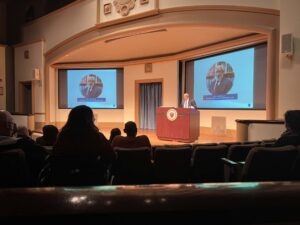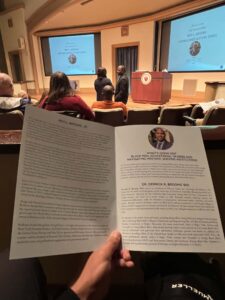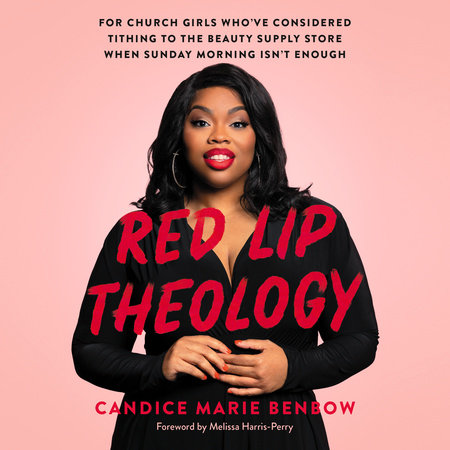Nicole Escamilla
Dr. Channon Miller
HIST 128
22 May 2023
.jpeg)
Red Lip Theology
Through the recorded event from the San Diego Central Library hosted about a month ago, I was able to listen to Candice Marie Benbow’s personal journey as a Theologian and what that entails for a woman of color in the religious field. She highlights her background as a seminary student and how this part of her identity shaped many of the outcomes of her interactions with uncomfortable situations. She described the construction of her book, titled Red Lip Theology, and the defining moments in her life that led to its production. The narratives and themes of this program are significant to our understanding of African American History because they shed light on the significance of Black womanhood within faith institutions, address the role scripture plays within the Black faith community, and provide a call to action from white people towards a safer future for the Black community to grow.
Candice explained that one of the goals she had in mind when writing this book was to create a space for the recognition of the important accomplishments black women have contributed to female, Black, American, and global historical contexts. She voiced how, “Black women are never heralded as forerunners for religious history”. This is something that is not talked about enough and that carries a lot of damaging consequences for any young woman of faith. Growing up only hearing of male religious figures and the greatness they have achieved, consolidates the narrative that women have no place for leadership roles within a faith institution. A lot of Candice’s work within her book is grounded in an effort to navigate the identities she carries and how they interact within her faith. She mentions how both of her parents were significantly involved within the Church community. However, only her mother was expected to be publicly chastised for her sins while her absent father was celebrated throughout the community. One of the recurring questions Candice brings up revolves around what women, particularly Black women, are owed “for their commitment to religion despite the marginalization they experience within the church”. There are many Black female theologians who are not mentioned throughout history – one example Candice mentions is Dr. Prathia Hall. In our text, we read how “men dominated church leadership”, despite the fact that “women constituted most of the members” (White 529). Not only do they make up the majority of congregations, Black churches relied on the support of females disproportionately. Females were in charge of funding and speaking on behalf of the church while not receiving credit for their contributions. This became more apparent after “invisible” slave churches became institutional churches. As these African American churches became “visible political institutions, Black women receded in visibility” (Green 123). Although there were some feminists advocating for equality within the church, there were others who believed the fight for women’s equality was a distraction from the overall fight for Black equality. Still, there were others who charged the feminist movement as already solved (Green 117).
Another important factor Candice mentioned that impacts our understanding of African American History was the role of scriptures within the Black community and the way in which they affected their journey in America. Candice shared how many Black people refused to read any scriptures written by the apostle Paul. This was because of his sexist background and his advocacy for enslavement – which would later be used as a biblical reference to justify oppression throughout history. She explained that within Black faith communities, there is a level of “interrogation” that must be utilized in order to uphold the integrity of their beliefs. Exposing these practices to those outside of the black community is extremely imperative and beneficial because it serves as a method of decentering one’s self and shifting the focus towards basing your religious pursuits to be in line with your individual morals and values. This goes to show how different the religious experience is for the Black community because of the conflicting lessons being enforced by different authors of biblical texts. By cutting out certain authors from religious instruction, the Black community pays significance to their tortured history and refuses to blindly follow a narrative that does not apply to their identity. Candice mentioned how ignorant people will dismiss the Black faith experience with their microaggressions, suggesting that the correct way to participate in spiritual practices must be in line with how white people practice. Most of the criticism of not wanting to read every scriptural text comes from the idea that it is undermining the foundations of faith. However, taking in historical contexts and painful past experiences is necessary to understand why some of these biblical authors and works are not applicable to those who use spirituality as a source of safety and freedom. Tying this aspect back in regards to women’s role in religion also works to highlight the double standard within these systems. While it is common for many Black male ministers to reject Paul’s teachings of slaves obeying their masters, the same advocacy is not extended to women in regards to the sexist remarks Paul vocalized.
The final method in which this program is significant to understanding African American History is through its “charge” to white people. Candice effectively communicates the importance of white people taking the time to reflect on their role in faith systems and their role as people of faith in general within society. This charge asks that they “decenter” themselves from the narrative – this is where African American History is of utmost importance. Recognizing the atrocities of the past and making strides towards better understanding the Black experience makes it possible for white people to question the integrity of their beliefs. This is important because it not only makes their religious outlook more inclusive, it solidifies the strength of their religious identity. If one is able to understand the power behind Christianity in America and the role it plays in White supremacy, this makes it easier to make the changes necessary to align their Christian faith with a world that considers the African American narrative. Ultimately, the white community must make efforts to shift the balance of powers and develop a space for the Black community to grow and thrive. White members of faith communities are charged with reflecting on whether their beliefs are rooted in white supremacy and are called to evolve their faith systems to include Black people in their consideration towards making the world a safer place for all. This includes allowing others’ approaches to faith to differ from their own – the faith experience is not defined by white standards. One of the questions brought up by an audience member asked what a white person’s prayer for guidance on this topic may look like. Candice replied by tasking them with the accountability to extend the standard of safety they are accustomed to those outside the white community. By recognizing their privileges and ridding themselves of the belief that one should benefit from whiteness, they can allow themselves to be honest about the integrity of their faith.
Overall, Candice used the production of her book as an opportunity to understand the interactions of her identity as a Black Millennial woman with ties to the church and pop culture. With influences from faith and feminism, Candice brought awareness to wounds, questions, and issues within faith systems that must be addressed. By exposing the gender inequalities within the church, the difference in scriptural significance, and the necessity for white people to address their role in these faith systems, Candice reminds us of the importance of acknowledging and understanding African American History and considering its context as we strive for inclusivity. By examining the journey and exclusion Black women have undergone in the faith community, we are called to analyze the ways in which we commend their contributions and pay tribute to their efforts as we move forward.
Works Cited
Green, TeResa. “A Gendered Spirit: Race, Class, and Sex in the African American Church.” Race, Gender & Class, vol. 10, no. 1, 2003, pp. 115–28. JSTOR, http://www.jstor.org/stable/41675063. Accessed 17 May 2023.
White, Deborah G., et al. “Chapter 9 Reconstruction: The Making and Unmaking of a Revolution.” Freedom on My Mind: A History of African Americans, with Documents, Third ed., Bedford/St. Martins, Boston, 2021.





